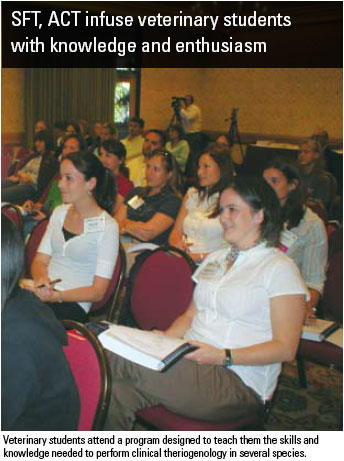Students engaged by theriogenology survival program
 Forty-nine veterinary students learned about the skills and knowledge needed to perform clinical theriogenology during a specially designed program at the Society for Theriogenology/American College of Theriogenologists annual conference in Monterey, Calif. The five-hour, Intervet-sponsored program Aug. 9-10 featured some of the leading experts in their respective fields of theriogenology.
Forty-nine veterinary students learned about the skills and knowledge needed to perform clinical theriogenology during a specially designed program at the Society for Theriogenology/American College of Theriogenologists annual conference in Monterey, Calif. The five-hour, Intervet-sponsored program Aug. 9-10 featured some of the leading experts in their respective fields of theriogenology.
AVMA President Gregory S. Hammer addressed the students, saying he believes it is important for the veterinary industry to put forth the effort to support educational programs such as this. Dr. Hammer told the students, "You will have a lot of respect in your community because of the 'Dr.' in front of your name, but you will also have a lot of responsibility. Part of that responsibility is (that) you will need to help mentor and nurture those who follow you in the profession."
The Senior Vet Student Survival Program developed by Intervet comprised five sessions, each of which focused on a species. The information was compiled and presented by ACT diplomates. Drs. Margaret Root Kustritz (companion animal), Dirk Vanderwall (equine), Cliff Shipley (porcine), Carlos Risco (bovine), and Ahmed Tibary (small ruminants and camelids) provided the students with an enthusiastic perspective about theriogenology.
It was not possible to cover all the essential material about reproduction in a species in a one-hour presentation, so each speaker's objective was to reiterate some of the basic principles and most important aspects of theriogenology for their given species. Dr. Root Kustritz, for example, reviewed the techniques for obtaining vaginal cells from bitches and the cytologic changes that would be evident during the various stages of the estrous cycle of dogs. Dr. Vanderwall highlighted the hormonal changes of mares during the equine estrous cycle and the products that veterinarians can use to alter or mimic the physiologic status of mares. Dr. Shipley spoke on the anatomy and physiology of the reproductive tracts in sows and boars, pregnancy diagnosis in swine, and a few of the major reproductive diseases that affect pigs.
In addition to the on-site presentations, each speaker compiled a set of notes and provided the slide materials they used. Each attending veterinary student received a bound copy of the notes and an electronic version of the presentations.
Dr. Bill Burdett, technical services specialist for cattle at Intervet, indicated the genesis of the program.
"Intervet was looking for something that could be done to help veterinary students who would be coming into clinics or would be preparing for boards," Dr. Burdett said. "The program was tailored for third- and fourth-year veterinary students, but all veterinary students can benefit. It was even beneficial for first-year theriogenology residents."
Why choose theriogenology? "Intervet is an important provider and partner to the veterinary community when it comes to reproduction products and support programs," Dr. Burdett said. "We also have an extensive veterinary school program. Collaborating with the SFT/ACT to improve further our common outreach to the veterinary students was a natural extension of our existing school initiatives."
In addition to the excellent presentations, other inducements were used to attract veterinary students to attend the program. Several students who are members of the Student SFT chapter at their school and had preregistered for the SFT/ACT annual conference received a travel stipend from Intervet to attend. Also, a reception was held in the evening after the completion of the first three presentations, which allowed the students to enjoy some delicious food and to network with members of the ACT and SFT executive boards, who share their zeal for theriogenology.
The program appeared to hit the mark. Chase Whitworth, a fourth-year student at Auburn University, indicated that the sessions were informative. Whitworth said, "This definitely will help me for boards. They talked about items such as gestation length and estrous cycles, which would likely be on the test."
Taylor Joyner, a second-year veterinary student at Oregon State University, also believes she benefited from the session, even though she won't be taking board examinations for a couple years. Because of the sessions, she is greatly anticipating her clinical rotations in theriogenology. Joyner said, "It's been a great overview. Each speaker has a true passion for their specialty and the species they deal with. The notes will be invaluable when I hit clinics. I'm excited!"
Each session was video recorded. Intervet intends to provide a DVD to every third- and fourth-year veterinary student at the U.S. veterinary schools. The DVD will include the presentations and a copy of the compiled notes.
Planning is already under way for the next theriogenology survival program, at the 2008 SFT/ACT annual conference in St. Louis, Aug. 12-16. The success of the inaugural program should entice more students to attend in subsequent years. Intervet would like to expand the theriogenology survival program next year and to provide similar survival programs on other topics in the future.